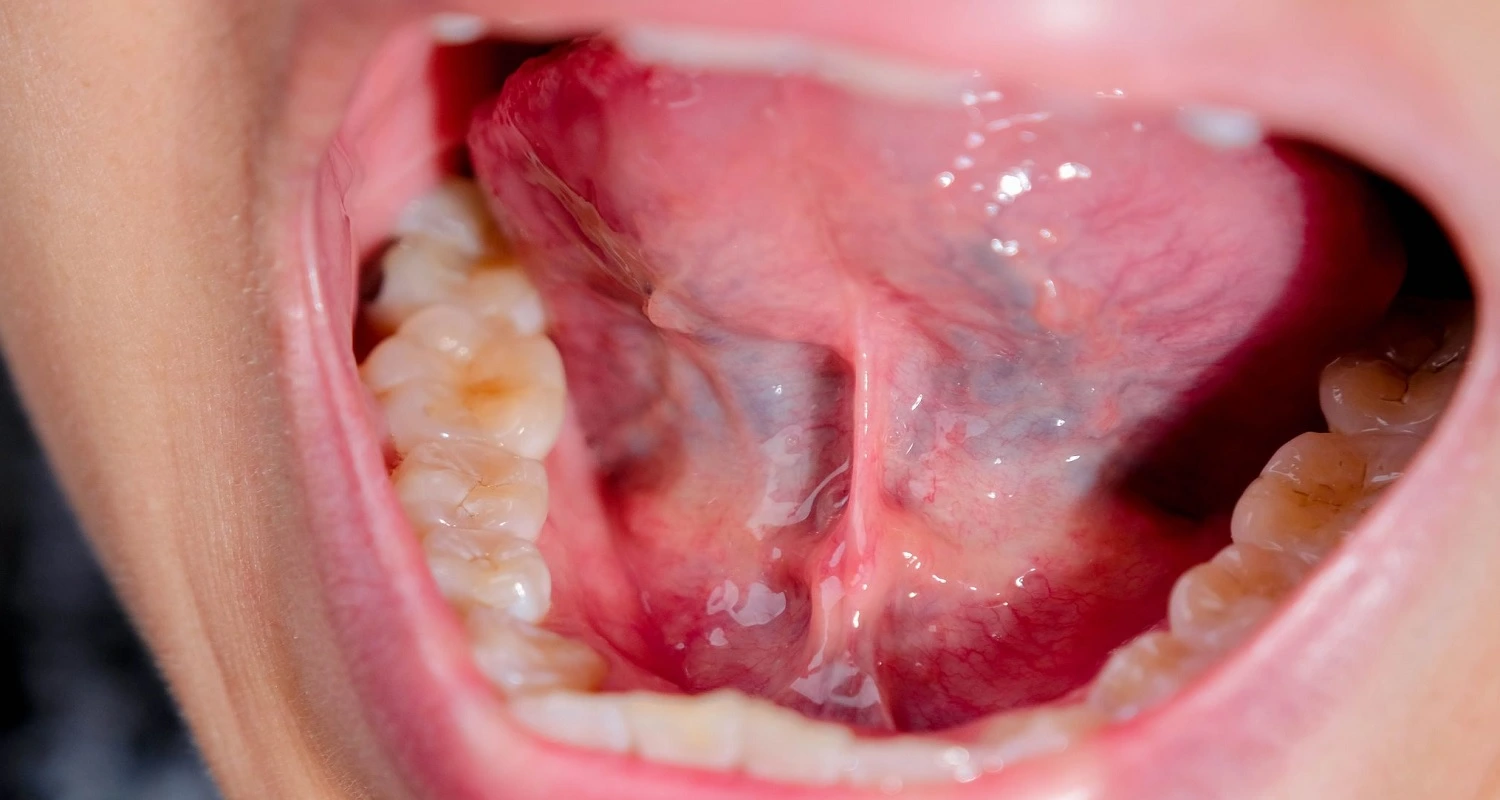Soft palate cancer is a specific type of oral cancer it can occur on the tongue, gums, throat, floor, or roof of the mouth, among other areas. Cancer is a disease that can affect any part of the body. It occurs when normal, healthy cells become abnormal cells that grow and multiply uncontrollably, generating masses known as tumors.
Recent estimates from the American Cancer Society report some 54,540 new cases of oropharyngeal or oral cavity cancer by the year 2023, being more common in men over 64 years of age than in women and young people.
In this article, cancer of the palate will be discussed. You will learn about the causes, symptoms, and how to deal with this disease. Find out the steps you can take to improve your prognosis.
What is Soft Palate Cancer?
Soft palate cancer is a rare form of cancer that affects the back of the roof of the mouth, behind the teeth. It is the soft section between the hard palate (the bony section at the roof of your mouth) and the uvula (a small piece of tissue that hangs down at the back of your throat).
It represents about 5 to 12% of all oropharyngeal cancers. It is considered throat cancer, due to its location. The majority of cases of oral and oropharyngeal cancer are carcinomas of thin, flat cells that form in the lining of the mouth and throat, known as squamous cells.
Signs and Symptoms
Knowing the signs and symptoms of soft palate cancer is important to detect it early. In the initial stages, the most common sign of oral cancer is the appearance of an ulcer or a painless white or red spot that does not heal.
The initial ulcer progresses, and the following signs and symptoms may appear:
• Bleeding
• Difficulty swallowing food or liquids (dysphagia)
• Difficulty speaking
• Difficulty opening the mouth
• Bad breath (halitosis)
• Chronic pain in the mouth
• Mouth sores that do not heal and may hurt or bleed
• Weight loss
• Earache
• Sore throat (pharyngitis)
• Swelling in the neck area
• White patches in the mouth that do not go away
Causes and Risk Factors
Normally healthy cells grow, multiply at a certain rate, and then die; but with soft palate cancer, healthy squamous cells mutate or become cancer cells that multiply and do not die, but rather become tumors.
Cancer cells invade nearby tissue and can later break away from the initial tumor and spread to other parts of the body (metastasize).
Certain habits and lifestyles can increase the risk of soft palate cancer; among them are:
• Tobacco use: smoking cigarettes and chewing tobacco.
• Regular consumption of alcoholic beverages
• Being infected with the human papillomavirus (HPV)
• Taking medications that suppress the immune system: some medicines decrease the body’s immune response capacity, so it is important to have medical control regarding the medications you take.
• People over 65 years of age: associated with prolonged exposure to risk factors.
If in addition to smoking a person also consumes alcoholic beverages, the risk of developing oral cancer is even higher. Here is our other information regarding alcohol you can read here.
Diagnosis When Having a Soft Palate Cancer
Normally, the professional who makes the diagnosis of soft palate cancer is the dentist, since during a routine consultation they can observe the area and determine if there are any signs of this disease.
Some tests and procedures to diagnose oral cancer are:
• Soft palate clinical exam: With the help of a mirror and in some cases the use of a small camera, the doctor or dentist can examine the soft palate, uvula, and part of the throat.
• Biopsy: The specialist doctor or dentist can remove a piece of tissue for analysis in a laboratory, where the pathologists will look for signs of cancer.
• Imaging study: Computed tomography (CT), magnetic resonance imaging (MRI), and positron emission tomography (PET) will help determine the size and progression of the cancer in the affected tissues.
Treatment
Treatment for soft palate cancer depends upon factors such as size, location, health status, and the needs and preferences of the patient.
Treatment options include:
• Surgery to remove the tumor: The goal of surgery is to remove as much of the cancer as possible; depending upon the size and extent of the lesion it may require hospitalization. When the cancer has spread to the lymph nodes in the neck, removal of the lymph nodes is necessary.
• Radiotherapy: High doses of ionizing radiation are used to destroy cancer cells and shrink tumors. Radiotherapy can be used in all stages of cancer, alone or with chemotherapy or removal surgery, depending upon each case.
• Chemotherapy: It consists of the use of chemical substances (drugs) to kill cancer cells. It can be combined with radiotherapy.
Recovery and Rehabilitation
After treatment for soft palate cancer, the patient requires follow-up medical and dental appointments to assess general and oral health status.
Additional interventions may be required during and after cancer treatment, such as:
• Reconstructive surgery
Depending upon the location and extent of the cancer, it may be necessary to rebuild lost tissue through surgery.
• Rehabilitation services
Speech therapy, swallowing therapy, physical therapy, or nutrition check-ups may be necessary after receiving cancer treatment.
• Palliative care
Specialized doctors can help you relieve pain and control the symptoms of the disease; additionally, they can provide support to family members and help them cope with this medical condition in the best possible way.
How to Deal with Soft Palate Cancer?
Receiving a cancer diagnosis is usually alarming and difficult to assimilate. There is a lot of ignorance around this topic, but nowadays medicine has advanced a lot, and the current methods of detection and treatment are quite effective.
While receiving cancer treatment, your emotional state must remain at a positive level, the following recommendations will be of great help:
• Learn about cancer: Investigate and ask the doctor about your cancer, the recommended treatment, and the stages, including prognosis. With this information, you will be able to take ownership of the subject and feel more in control of your health.
• Stay close to family and friends: Good interpersonal relationships are of great help not only as practical support but also as emotional support.
• Find someone to talk to: It can be a support group, a family member, a friend, a doctor, or a clergy member, among others. Talking to someone you trust, to whom you can express your fears, feelings, and concerns will be of great help.
Prognosis and Prevention
Soft palate cancer can be cured and has a good prognosis if detected at an early stage. It is recommended to schedule periodic dental consultations at least every 6 months to determine in time if there is an anomaly at the level of the soft palate and, in general, throughout the oral cavity.
The risk of soft palate cancer can be reduced by following these tips:
• Do not use tobacco: If you are a smoker, look for a strategy to quit.
• Limit alcohol consumption: If you choose to consume alcohol, do so in moderation.
• Regular visits to the dentist
• Get vaccinated against HPV: Ask your doctor if the human papillomavirus vaccine is appropriate for you.
Cancer can occur anywhere in the body; Generally, in the initial stages, it is not usually painful, and the reason those who suffer from it do not know that they have it. It is important to take preventive measures since the treatment of any cancer detected in time is less aggressive and has a better prognosis. Additionally, complications such as metastasis may be avoided.
When presenting any of the symptoms mentioned in this article, urgently seek a dental consultation to diagnose or rule out possible cancerous lesions.
Frequently Asked Questions
What is the initial phase of soft palate cancer?
The emergence of soft palate cancer is typically observed as an oral ulcer. Initially, the ulcer is devoid of pain, but eventually, it becomes painful. Risk factors for cancer of the soft palate include tobacco and alcohol use. Treatment options for soft palate cancer encompass surgery, radiation, and chemotherapy.
How severe is cancer of the palate?
If left untreated, hard palate cancer can potentially metastasize to the lymph nodes in the neck and nasal passages. Cancer cells can travel through the lymphatic system, forming new tumors, known as metastases, in different parts of the body.
How common is it palate Cancer?
Palate cancer, specifically cancer of the hard palate, is relatively uncommon. Globally, approximately 54,000 cases are diagnosed each year. To gain further insights into this rare form of cancer, including its diagnosis and treatment.
Can soft palate cancer be treated and cured?
Doctors and medical professionals have ways to help cure soft palate cancer, especially when it is found in the early stages. They can use surgery to remove small tumors or radiation therapy to treat the cancer. Early-stage cancer means that the tumors are still small and haven’t spread. Even some cancers that are found in later stages can also be cured with the right treatments.
Share:
References
1. Johnson, D., Burtness, B., Leemans, C. R., Lui, V. W. Y., Bauman, J. E., & Grandis, J. R. (2020).Head and neck squamous cell carcinoma. Nature Reviews Disease Primers, 6(1). https://doi.org/10.1038/s41572-020-00224-3
2. Oral Cavity & Oropharyngeal Cancer Key Statistics 2021. (Reviewed: January 18, 2023). American Cancer Society. https://www.cancer.org/cancer/types/oral-cavity-and-oropharyngeal-cancer/about/key-statistics.html
3. Patru, A., Surlin, V., Mărgăritescu, C., Ciucă, E. M., Mărgăritescu, O., & Camen, A. (2020).Palate Squamous Cell Carcinomas: A Ten-Year Single Institute Experience. Current health sciences journal, 46(4), 358-370. https://doi.org/10.12865/chsj.46.04.06
4. Soft Palate Cancer. (Reviewed: February 28, 2023). Cleveland Clinic. https://my.clevelandclinic.org/health/diseases/24791-soft-palate-cancer
5. Soft palate cancer. (Updated: August 30, 2021). Sparrow. https://www.sparrow.org/departments-conditions/conditions/soft-palate-cancer
6. Soft palate cancer – Diagnosis and treatment (August 31, 2021). Mayo Clinic. https://www.mayoclinic.org/diseases-conditions/soft-palate-cancer/diagnosis-treatment/drc-20445530
7. Soft palate cancer – Symptoms and causes. (August 31, 2021). Mayo Clinic. https://www.mayoclinic.org/diseases-conditions/soft-palate-cancer/symptoms-causes/syc-20354183
8. What Are Oral Cavity and Oropharyngeal Cancers? (Reviewed: March 23, 2021). American Cancer Society. https://www.cancer.org/cancer/types/oral-cavity-and-oropharyngeal-cancer/about/what-is-oral-cavity-cancer.html
9. Young, A. (Updated: January 12, 2023). Malignant Tumors of the Palate. StatPearls. https://www.ncbi.nlm.nih.gov/books/NBK564515/
-
Nayibe Cubillos M. [Author]
Pharmaceutical Chemestry |Pharmaceutical Process Management | Pharmaceutical Care | Pharmaceutical Services Audit | Pharmaceutical Services Process Consulting | Content Project Manager | SEO Knowledge | Content Writer | Leadership | Scrum Master
View all posts
A healthcare writer with a solid background in pharmaceutical chemistry and a thorough understanding of Colombian regulatory processes and comprehensive sector management, she has significant experience coordinating and leading multidisciplina...


















